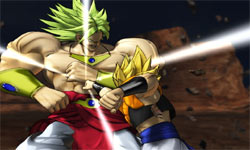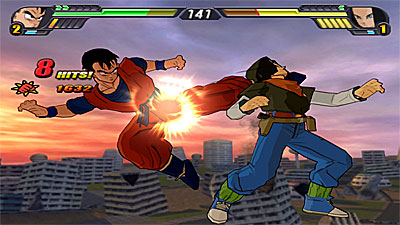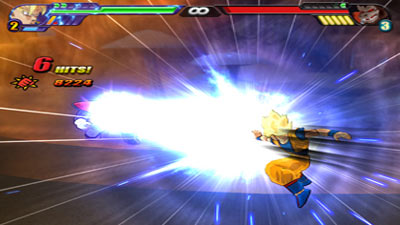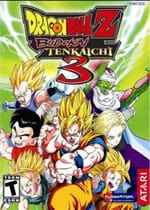The last Saiyan outing on the PS2
The Dragon Ball Z franchise is one of the most well known and enduring animes and one of Atari’s most beloved licenses. Each year, anime aficionados can expect a new DBZ game to showcase the antics of Goku as he protects the universe from various threats. Atari’s newest title, Dragon Ball Z: Budokai Tenkaichi 3 is the latest in the series, and although some of the BT3’s additions should have been included in the last game, there is no denying that BT3 is the best in the series to date.

One major problem with the Dragon Ball Z franchise is that the anime series has been completed for a long time, which means that each new game is basically retelling the same old story again and again, rehashing it in a vain attempt to make it fresh. This year’s story mode is probably the best attempt to date to recreate the DBZ experience for the fans and make the experience enjoyable. Dragon History, which is this year’s version of the story mode, allows you to play through the various sagas that comprise the Dragon Ball Z, Dragon Ball, and Dragon Ball GT series. You will get to reenact some of the larger battles in the series, but this time, the game emulates the actual anime more, having the combatants talk and taunt one another during the fights. Also, sidelined friends also comment throughout the fights, encouraging you when you’re being throttled and cheering you on when you’re defeating your foe. The dialogue really conveys the spirit of the show, with spoken lines that, while not direct quotes, feel sometimes as if they should have been. There are also moments during gameplay where a prompt asks you to press the R3 button, which will initiate the next segment of combat, whether it is starting a blast battle or the next batch of dialogue. You have the option of ignoring the prompt and reshaping the battle so that it doesn’t go according to DBZ canon, but there aren’t any major alterations to any storyline.
Dragon History is a good version of story mode, but it is criminally short, cutting out a good number of the battles featured in the last iteration. Some battles jump from one point to another, cutting out a great deal of potential fights, such as the curious choice to start the Freiza Saga at Goku’s fight with Recoome, completely ignoring possibilities like Vegeta’s fights with Dodoria and Zarbon. If the developers had kept all of the battles from BT2 and incorporated them into Dragon History, it would have been the best story mode to date, but by omitting so many crucial battles, the story mode feels rushed and incomplete. Also, Dragon History uses the game’s fighting engine to recreate all of the fights and “cutscenes”, so there will only be two fighters onscreen at a time despite comments coming from various characters. The off-screen characters don’t have any representation at all besides their voice, and it seems like the developers would have at least included a text box with the off-screen character’s face instead of just voice and text. Anyone unfamiliar with Dragon Ball Z wouldn’t know who was talking or what was occurring.

The fighting has been reworked to make the gameplay much deeper than previous versions. Additions like the Sonic Sway, which lets you dodge attacks and counterattack, and Z Burst, which lets you zoom in on a foe’s blindside, deepen the gameplay considerably, although the addition of the Z-counter intensifies the gameplay the most, extending the quick teleport counterattacks that are the show’s trademarks. A fighter can find himself ping-ponged between a foe’s quick teleportation attacks, but with great timing can instantly turn the tables on an opponent. Nearly all of the attacks in the game can be countered, reversed, or avoided, making the gameplay interesting for anyone diligent enough to learn and explore the combat system. Also, the A.I. in the game is much improved, making the game far more challenging and requiring everyone to learn at least some of the tricks in the game to survive.

Visually, the game is stunning. There isn’t much more that the developers can do to maximize the game’s look, especially considering that the game is released on last gen tech. The previous Budokai Tenkaichi looked much better than the actual anime, and BT3 improves upon that formula, making the energy attacks more dynamic and lively, the character models look sharper, and the game look more polished. The returning characters’ attacks all looked flashier, creating new, incredible effects that we didn’t know we were missing in Budokai Tenkaichi 2.

Beyond the Dragon History Story mode, there is still a ton to do in BT3. The Disc Fusion system, which honestly feels like a consolation prize for the online-less PS2 version, unlocks ranking battle from previous BT games, which is a nice addition but doesn’t effectively replace online versus. There are still tournament modes which lets you fight against the CPU in different battles, which introduces the Otherworld Tournament for BT3. Sim Dragon Mode gives you ten days to prepare for battle, giving you the option to simulate training, exploring, or resting. After your ten days have passed, you fight a foe and, if you win, continue the process, fighting stronger foes to earn Z-points. Mission 100 pits you against a team of themed enemies. Character Reference lets you check out character histories, models, and even get a commentary on everyone from Chi-Chi. Combine all of these different modes with the fact that there are over 150 playable characters and most DBZ fans will find themselves occupied for a long time.
Speaking of the characters, there are a wide variety of characters representing DBZ, DB, and GT. Included this time around are BT2 oversights like GT Kid Goku and Nouva Shenron, but oddly, the developers added a single shadow dragon out of seven. It was almost a given that Nouva’s brother Eis would be added, but he was curiously omitted for some reason.
There are also a lot of little touches that the developers added to polish the game. Characters can still be customized by Z-items, which now can have negative effects to counter the positives. Instead of having one customized character, you now have slots that allow you to keep up to three other customize slots per character. There are also three loading screen minigames instead of the usual one, which is a superfluous but welcome addition, since I quickly grew tired of Yamcha’s minigame from the previous game. BT3 also give the option to replay and save battles that you participate in.
Overall, Budokai Tenkaichi 3 is undeniably the best DBZ game to date. The fighting engine has been considerably deepened, the Dragon History mode is flawed but great, and the graphics far surpass the anime. There are a ton of different modes to play, a bunch of new characters, over 20 stages, and more action oriented gameplay. Though there are a few questionable missteps, Dragon Ball Z: Budokai Tenkaichi 3 is a must have for any Dragon Ball Z fan.
Features:
RATING OUT OF 5 RATING DESCRIPTION 4.0 Graphics
Visually better than the anime, faithfully recreating Goku and pals 3.8 Control
Much deeper fighting engine is responsive and well done 4.0 Music / Sound FX / Voice Acting
Voice actors reprise and recreate their roles 3.8 Play Value
A ton to do for fans of DBZ 4.0 Overall Rating – Great
Not an average. See Rating legend above for a final score breakdown.
